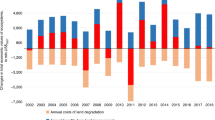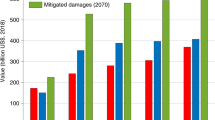Abstract
This paper is motivated by the observation that there is a difference between the time paths of damage valuations for invasions which affect agricultural compared with environmental systems. In particular, unlike agricultural systems, social valuation of an environmental system is likely to be exponentially positively related to the extent of its deterioration. This paper explores the implications of this difference in determining biosecurity investment priorities where criteria for decision-making are relatively narrow. It is concluded that because of this difference an environmental system will often not be prioritised for such protection over an agricultural system even though its ultimate social value exceeds that of the agricultural system. For this reason a broader set of decision criteria are needed that enable decision-makers to learn more about the context of biosecurity investment decisions.

Similar content being viewed by others
Notes
The term IAS applies when the abundance and distribution of a non-native (or alien) organism exceeds a defined and accepted environmental standard, resulting in a net negative effect on social welfare (Cook et al. 2010b).
This specification of uniformity is made to simplify the biological component of the model and will be reviewed in section three.
Here the maintenance of rural populations is associated with environmental damage mitigation, so it is difficult to draw conclusions about the willingness of society to pay for the preservation of rural communities per se due to embedded environmental values.
References
ABARE (2006) Australian Commodity Statistics. Australian Bureau of Agricultural and Resource Economics
ABARE (2010) Australian Farm Survey Results, 2007–08 to 2009–10. Australian Bureau of Agroicultural and Resource Economics, Canberra
ABS (2004) AgStats Integrated Regional Database, Catalogue No. 1353.0. Australian Bureau of Statistics, Canberra
Adamowicz WL (2004) What’s it worth? An examination of historical trends and future directions in environmental valuation. Aust J Agric Resour Econ 48:419–443
Agtrans Research, Dawson N (2005) Review of progress on invasive species. Final report to Department of Environment and Heritage. Agtrans Research, Brisbane
AGWEST Trade and Development (2003) AGTRADE Database. Government of Western Australia—Department of Agriculture, South Perth
Andrée P (2000) The supervision of health and biosafety regulation by world trade rules. Tul Envtl L J 13:271–302
Baker RHA, Black R, Copp GH, Haysom KA, Hulme PE, Thomas MB, Brown A, Brown M, Cannon RJC, Ellis J, Ellis M, Ferris R, Glaves P, Gozlan RE, Holt J, Howe L, Knight JD, MacLeod A, Moore NP, Mumford JD, Murphy ST, Parrott D, Sansford CE, Smith GC, St-Hilaire S, Ward NL (2008) The UK risk assessment scheme for all non-native species. In: Neobiota—from ecology to conservation: the 4th European conference of the working group NEOBIOTA on biological invasions, Vienna, Austria, pp 46–57
Bennett J, van Bueren M, Whitten S (2004) Estimating society’s willingness to pay to maintain viable rural communities. Aust J Agric Resour Econ 48:487–512
Blamey R, Rolfe J, Bennett J, Morrison M (2000) Valuing remnant vegetation in Central Queensland using choice modelling. Aust J Agric Resour Econ 44:439–456
Booth C (2008) Submission to the quarantine and biosecurity review. Invasive Species Council, Brisbane
Bowornwathana B (1996) The Phenomenon of new ministries and the politician-bureaucrat perspective: the case of Thailand. Asian Rev Public Adm 8:23–32
Burgman M, Fidler F, McBride M, Walshe T, Wintle B (2006) Eliciting expert judgements: literature review. Australian Centre of Excellence for Risk Analysis, Melbourne
Convention on biological diversity (1991) Convention text. Convention on biological diversity
Cook DC (2003) Prioritising exotic pest threats to Western Australian plant industries. Government of Western Australia—Department of Agriculture, Bunbury
Cook DC, Fraser RW (2008) Trade and invasive species risk mitigation: reconciling WTO compliance with maximising the gains from trade. Food Policy 33:176–184
Cook DC, Matheson AC (2008) An estimate of the potential economic impact of pine pitch canker in Australia. Aust For 71:107–112
Cook DC, Proctor WL (2007) Assessing the threat of exotic plant pests. Ecol Econ 63:594–604
Cook DC, Thomas MB, Cunningham SA, Anderson DL, De Barro PJ (2007) Predicting the economic impact of an invasive species on an ecosystem service. Ecol Appl 17:1832–1840
Cook DC, Hurley M, Liu S, Siddique A-BM, Lowell KE, Diggle A (2010a) Final report CRC10010 enhanced risk analysis tools. Cooperative Research Centre for National Plant Biosecurity, Canberra
Cook DC, Liu S, Murphy B, Lonsdale WM (2010b) Adaptive approaches to biosecurity governance. Risk Anal 30:1303–1314
Dragan M, Feoli E, Fernetti M, Zerihun W (2003) Application of a spatial decision support system (SDSS) to reduce soil erosion in northern Ethiopia. Environ Model Softw 18:861–868
Fisher R, Ury WL (1991) Getting to yes: negotiating agreement without giving in, 2nd edn. Penguin, New York
Frank J (2008) Is there an “animal welfare Kuznets curve”? Ecol Econ 66:478–491
Fraser RW, Cook DC, Mumford JD, Wilby A, Waage JK (2006) Managing outbreaks of invasive species: eradication versus suppression. Int J Pest Manag 52:261–268
GATT (1994) Agreement on the application of sanitary and phytosanitary measures. The results of the Uruguay Round of multilateral trade negotiations: the legal texts. General Agreement on Tariffs and Trade Secretariat, Geneva, pp 69–84
Gilmour J, Beilin R (2006) Stakeholder mapping for effective risk assessment and communication. Australian Centre of Excellence for Risk Analysis, Melbourne
Hanley N, MacMillan D, Patterson I, Wright RE (2003) Economics and the design of nature consewrvation policy: a case study of wild goose conservation in Scotland using choice experiments. Anim Conserv 6:123–129
Hodda M, Cook DC (2009) Economic impact from unrestricted spread of potato cyst nematodes in Australia. Phytopathology 99:1387–1393
Jankowski P, Nyerges T (2001) GIS-supported collaborative decision-making: results of an experiment. Ann Assoc Am Geogr 91:48–70
Linkov I, Varghese A, Jamil S, Seager TP, Kiker G, Bridges T (2004) Multi-criteria decision analysis: a framework for structuring remedial decisions at contaminated sites. In: Linkov I, BakrRamadan A (eds) Comparative risk assessment and environmental decision-making. Kluwer Academic, Amsterdam, pp 15–54
Liu S, Proctor W, Cook D (2010) Using an integrated fuzzy set and deliberative multi-criteria evaluation approach to facilitate decision-making in invasive species management. Ecol Econ 69:2374–2382
Lonsdale W (1994) Inviting trouble: introduced pasture species in northern Australia. Aust J Ecol 19:345–354
McDaniels TL, Gregory RS, Fields D (1999) Democratizing risk management: successful public involvement in local water management decisions. Risk Anal 19:497–510
McKelvie L, Reid C, Haque M (1994) Economic impact of salmonid diseases: furunculosis and infectious haematopoeitic necrosis (IHN): report to the Australian quarantine and inspection service. Australian Bureau of Agricultural and Resource Economics, Canberra
Mumford JD, Knight JD, Cook DC, Quinlan MM, Pluske J, Leach AW (2001) Benefit cost analysis of mediterranean fruit fly management options in Western Australia. Imperial College, Ascot
Office of Technology Assessment (1993) Harmful non-indigenous species in the United States, OTA-F-565. US Government Printing Office, Washington, DC
Pheloung PC, Williams PA, Halloy SR (1999) A weed risk assessment model for use as a biosecurity tool evaluating plant introductions. J Environ Manag 57:239–251
Pimentel D, Lach L, Zuniga R, Morrison D (2000) Environmental and economic costs associated with non-indigenous species in the US. Bioscience 50:53–65
Pimentel D, Zuniga R, Morrison D (2005) Update on the environmental and economic costs associated with alien-invasive species in the United States. Ecol Econ 52:273–288
Roy B (1985) Méthodologie multicritere d’ aide à la decision. Roy B (1985). Méthodologie multicritere d’ aide à la decision Paris, Economica, Paris
Scholz JT, Stiftel B (2005) Introduction: the challenges of adaptive governance. In: Scholz JT, Stiftel B (eds) Adaptive governance and water conflict: new institutions for collaborative planning. Resources for the Future Press, Washington, DC, pp 1–11
Simberloff D (2006) Risk assessments, blacklists, and white lists for introduced species: Are predictions good enough to be useful? Agric Resour Econ Rev 35:1–10
Stansbury CD, Pretorius ZA (2001) Modelling the potential distribution of Karnal bunt of wheat in South Africa. South Afr J Plant Soil 18:159–168
Waage JK, Fraser RW, Mumford JD, Cook DC, Wilby A (2005) A New Agenda for Biosecurity Department for Food, Environment and Rural Affairs, London
Whitby M (2000) Challenges and options for the UK agri-environment: presidential address. J Agric Econ 51:317–332
Williamson M (1996) Biological invasions. Chapman and Hall, London
Wittwer G, McKirdy S, Wilson R (2005) Regional economic impacts of a plant disease incursion unsing a general equilibrium approach. Aust J Agric Resour Econ 49:75–89
Acknowledgments
We are very grateful to two anonymous reviewers for their helpful comments and suggestions. We would like to acknowledge the support of the Cooperative Research Centre for National Plant Biosecurity, established and supported under the Australian Government’s Cooperative Research Centres Program.
Conflict of interest
The author D. C. Cook declares that his contribution to the research was sponsored by the Cooperative Research Centre for National Plant Biosecurity and that he has no conflict of interest. The authors R. W. Fraser, J. K. Waage and M. B. Thomas declare that their contributions to the research were not sponsored and that they have no conflict of interest.
Author information
Authors and Affiliations
Corresponding author
Additional information
Conference Proceedings: “Decision Making and Science—The Balancing of Risk Based Decisions that Influence Sustainability of Agricultural Production”. 7th and 8th October 2010 in Berlin, Germany. Sponsored by the OECD Co-operative Research Programme.
Rights and permissions
About this article
Cite this article
Cook, D.C., Fraser, R.W., Waage, J.K. et al. Prioritising biosecurity investment between agricultural and environmental systems. J. Verbr. Lebensm. 6 (Suppl 1), 3–13 (2011). https://doi.org/10.1007/s00003-011-0689-0
Published:
Issue Date:
DOI: https://doi.org/10.1007/s00003-011-0689-0




